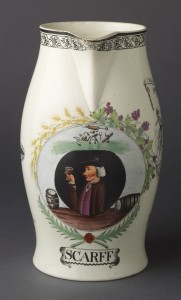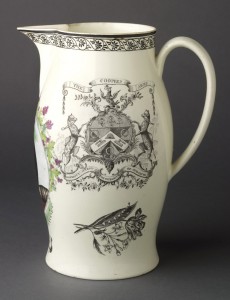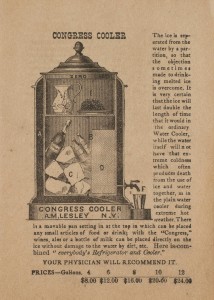Come, come let us drink the Vintners’ good health,
‘Tis the Cask, not the Coffer, that holds the true Wealth:
If to Founders of Blessings we Pyramids raise,
The Bowl next the Sceptre deserves the best Praise.
Then next to the Queen, let the Vintners fame shine:
So give us good Laws, and then fill us good Wine.
The Pageant Book of the Vintners’ Company (London, 1702)
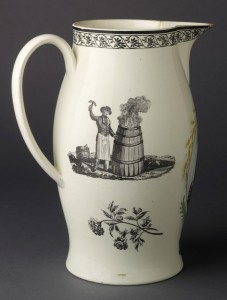 Coopers Arms jug
Coopers Arms jug
Probably Herculaneum Pottery
Liverpool, England; 1795–1805
Earthenware (creamware)
Inscribed “SCARFF,” “THE COOPERS ARMS” and “PROSPERITY ATTEND THE INTEGRITY OF OUR CAUSE”
Gift of S. Robert Teitelman 2009.21.5
A printed image on the side of this jug, which also bears the Arms of London’s Worshipful Company of Coopers, illustrates the process of cask-making. This required that vertical wooden staves be softened by heating, followed by driving down metal hoops to keep the staves in place. The name “CALVERT” on one barrel in the reserve under the pouring lip may refer to the family who received a royal charter to found the colony of Maryland.
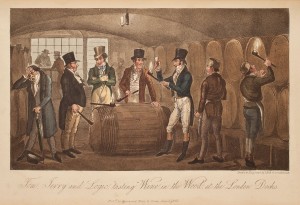 “‘tasting’ Wine in the Wood, at the London Docks” from Life in London; or, The day and night scenes of Jerry Hawthorne, esq., opposite p. 328
“‘tasting’ Wine in the Wood, at the London Docks” from Life in London; or, The day and night scenes of Jerry Hawthorne, esq., opposite p. 328
Pierce Egan (author), I. R. & G. Cruikshank (illustrators)
London, England: Sherwood, Neely and Jones, 1821
Printed Book and Periodical Collection, Winterthur Library PR4649 E28ℓ
At many ports, potential buyers had the option of sampling and buying wine “in the wood,” meaning still in the barrel. In this satirical London view, the elegantly attired wine tasters are holding up flames to observe the qualities of the wine. Importers, ship captains, and other agents often sold their newly arrived casked or bottled wines from warehouses or at dockside auctions. Getting one’s money’s worth during such purchases was problematic, as Cyrus Redding tells us in Every Man his Own Butler (1839):
The forms [of casks] differ in different provinces as well as the capacities . . . These differences have arisen from the measures being foreign. In France they call the cask by different names . . . and the capacities also differ, but not uniformly with the names.
Some common vessel sizes and types used in England and America include pints, quarts, old and new gallons, tierces, hogsheads, puncheons, pipes, and tuns.
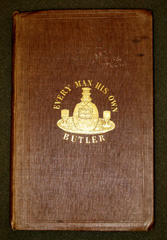 Every Man His Own Butler
Every Man His Own Butler
Cyrus Redding
London, England: Whittaker & Co., 1839
Printed Book and Periodical Collection, Winterthur Library TP548 R31
This fascinating book covers an astonishing range of information on all aspects of selecting, buying, serving, and storing wines. It lists wines by country and warns of differences in measures and pricing. The entertaining remarks in the chapter entitled “Wine Sayings of My Uncle” were presumably to be used during lapses in conversation at the dinner table:
Value wine like women, for maturity, not age. …
Claret for a bishop, port for a rector, currant for a curate, and gin for the clerk. …
Keep a butler who loves wine; it is better he should drink one bottle than give away two.
The Zero Refrigerators: With Water and Wine Cooler Combined, p. 29
Alex M. Lesley
New York, New York: By the author, about 1877
Printed Book and Periodical Collection, Winterthur Library TP496 L63 TC
“Don’t Spoil Wines in Serving” advertisement
United States; 1918–32
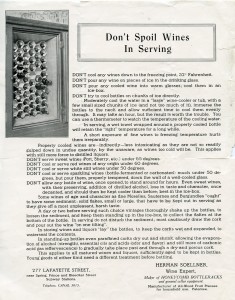 Museum Archives HF 438
Museum Archives HF 438
Even as wine casks were becoming less common features of household cellars, the challenge of keeping wines cool when in storage remained. The “Congress Cooler” was an innovative 19th- century refrigerator, allowing the storage of “wines, ales, or a bottle of milk” directly on ice near a separate compartment that dispensed chilled water. Such a unit probably would have been popular with Cyrus Redding (1839), who noted, “A wine-cellar too hot or cold / Murders wine before it’s old.”
The “Don’t Spoil Wines” advertisement survives among Henry Francis du Pont’s papers. It contains wine-storage and serving instructions provided byBostonmerchant Herman Soellner and illustrates a “Honeycomb Bottlerack” cooler.
Related Themes:

